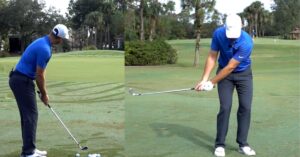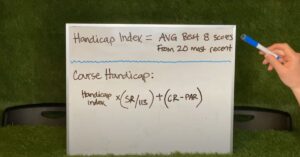What Is Rule of 12 in Golf: Unleashing Precision on the Greens
Golf is a game of precision, strategy, and calculated decision-making. From selecting the right club to reading the greens, golfers constantly seek methods to enhance their performance and lower their scores.
Among the many techniques employed by golfers, the Rule of 12 stands as a powerful tool for honing their short game.
The Rule of 12 is a simple yet effective method that golfers employ to estimate the distance their ball will roll when executing shots around the greens. It provides a guideline for choosing the right club and making precise adjustments for different situations.
This blog post delves into the intricacies of the Rule of 12 and how it can help you become a more proficient golfer around the greens.
What is Rule of 12 In Golf?
The Rule of 12 in golf is a technique used by golfers to help them choose the appropriate club to use when hitting a short shot around the green.
It involves taking the distance from the ball to the hole and subtracting it from 12 to determine the desired landing spot of the ball on the green.
For example, if the ball is 10 feet away from the hole, subtracting 10 from 12 gives a result of 2, indicating that the ball needs to land approximately 2 feet onto the green to reach the hole.
By using this technique, golfers can ensure that they choose a club that will allow them to hit the ball the appropriate distance and achieve the desired result.
It is particularly useful for shots where there is little room for error, such as when the ball is close to a bunker or water hazard.
The Rule of 12 is easy to remember and can be a helpful tool for golfers of all skill levels to improve their short game.
How Do You Calculate The Rule Of 12 In Golf?
The Rule of 12 in golf is a simple technique used to estimate how much a golf ball will roll on the green after landing.
It helps golfers make more accurate judgments when choosing a club and planning their shots around the green.
Here’s how you can calculate the Rule of 12:
Step 1: Assess the Distance
Stand on the green and assess the distance between your ball and the hole. You can use your feet, strides, or a rangefinder to estimate the distance accurately.
Step 2: Determine the Stimp Rating
The Stimp rating refers to the speed of the green. It is a measure of how fast the ball rolls on the putting surface.
The average Stimp rating is around 10-11, but it can vary depending on the golf course and its conditions.
If you’re unsure about the Stimp rating, you can ask the golf course staff or fellow golfers for an estimate.
Step 3: Divide the Stimp Rating by 12
Take the Stimp rating and divide it by 12. For example, if the Stimp rating is 10, dividing it by 12 gives you approximately 0.83.
Step 4: Calculate the Estimated Roll
Multiply the result from the previous step by the distance you assessed in Step 1. This will give you an estimation of how far the ball will roll on the green.
For example, if you assessed a distance of 20 feet and the Stimp rating is 10, the calculation would be: 0.83 (Stimp rating divided by 12) multiplied by 20 (assessed distance) equals approximately 16.6 feet of roll.
5 Benefits Of Using The Rule Of 12 In Chipping
The Rule of 12 in chipping is a valuable technique that can bring several benefits to your short game in golf.
By implementing this rule, golfers can make more accurate decisions and execute better shots around the green.
Here are some benefits of using the Rule of 12 in chipping:
1. Improved Distance Control
The Rule of 12 provides a simple and effective way to gauge how far the ball will roll after landing.
By understanding how different clubs and swings affect the roll distance, you can better control your chipping shots.
This helps select the appropriate club and adjust your swing length to achieve the desired outcome.
2. Consistency in Chipping:
Chipping can be a challenging aspect of the game, requiring precision and touch. The Rule of 12 offers a consistent method for chipping across various greens.
Once you become comfortable with this technique, you can apply it consistently to different chip shots, leading to improved reliability and confidence in your short game.
3. Simplified Decision Making
When faced with a chip shot around the green, the Rule of 12 simplifies the decision-making process.
By quickly assessing the distance and choosing the appropriate club based on the estimated roll, you can focus more on execution and less on analyzing the complex variables.
This streamlined decision-making can enhance your overall performance under pressure.
4. Adaptability to Different Conditions
The Rule of 12 is adaptable to varying green conditions and speeds. By adjusting the calculation based on the specific Stimp rating or feel of the greens, you can make accurate estimations regardless of the course or weather conditions.
This adaptability allows you to make quick adjustments and maintain consistency in your chipping, regardless of the environment.
5. Enhanced Scoring Opportunities
Chipping is a crucial aspect of scoring in golf. By using the Rule of 12 effectively, you can improve your ability to get the ball closer to the hole, reducing the number of putts needed to finish the hole.
This technique can lead to more up-and-down saves, fewer costly mistakes, and ultimately lower scores on the scorecard.
Tips For Practicing And Mastering The Rule Of 12
Practicing and mastering the Rule of 12 in golf can significantly improve your chipping skills and help you make better decisions around the green.
Here are some tips to enhance your practice sessions and become proficient in using the Rule of 12:
Select Different Clubs
Experiment with different clubs when practicing chipping with the Rule of 12. Use a variety of wedges, such as a pitching wedge, gap wedge, sand wedge, or even a 9-iron, to understand how each club affects the roll distance.
This practice will provide you with a better feel for different scenarios and help you develop a more versatile short game.
Focus on Consistent Swing Length
One of the keys to using the Rule of 12 effectively is having a consistent swing length.
Work on developing a repeatable and controlled chipping swing, where you can vary the distance by adjusting the backswing length rather than the force applied to the ball.
This helps you maintain better control and accuracy over your shots.
Practice Different Distances
Set up targets or place markers at various distances around the practice green. Practice chipping from different positions and aim to land the ball within the desired distance based on the Rule of 12.
This will help you develop a sense of distance control and improve your ability to assess and execute chip shots effectively.
Experiment with Green Speeds
Chipping conditions can vary based on the speed of the greens. Practice on different putting surfaces with varying speeds to simulate real-life scenarios.
Adjust your calculations based on the specific Stimp rating of each green and observe how the ball rolls.
This practice will sharpen your adaptability and decision-making skills when using the Rule of 12 on different courses.
Incorporate Realistic Scenarios:
To simulate on-course situations, practice chipping from various lies and uneven lies. Create challenging scenarios by placing the ball in rough or tight lies, uphill or downhill slopes, or near hazards.
This will help you develop the ability to adjust your club selection and execution based on the specific circumstances you may encounter during a round of golf.
Practice Visualization
Visualization is an essential aspect of effective chipping. Before each shot, visualize the trajectory, landing spot, and roll distance based on the Rule of 12. Develop a mental image of the shot you intend to execute.
This visualization technique can improve your focus, confidence, and ability to execute shots more accurately.
Track and Analyze Results
Keep track of your practice sessions and analyze the outcomes of your chip shots. Note the club used, estimated roll distance, and actual results.
Over time, you will notice patterns and better understand your personal tendencies and performance with different clubs and distances.
This self-analysis will help you refine your technique and make more informed decisions on the course.
Frequently Asked Questions
Curious about the Rule of 12 in golf and how it can assist in estimating putting distances? Here are some frequently asked questions to shed light on this popular technique used by golfers on the greens.
Is The Rule Of 12 Accurate For All Greens?
The Rule of 12 provides a rough estimate of distance and is most effective on medium-paced greens.
However, its accuracy may vary depending on factors such as the speed and slope of the green, the type of grass, and the golfer’s putting technique.
Can The Rule Of 12 Be Used For Uphill Or Downhill Putts?
While the Rule of 12 can still be used for uphill or downhill putts, it may require slight adjustments.
Uphill putts may roll slightly shorter than expected, while downhill putts may roll slightly farther.
It is advisable to practice and develop a feel for these adjustments.
Are There Alternative Methods To Estimate Putting Distances?
Yes, there are alternative methods, such as the Rule of 6 or the Rule of 9, which are variations of the Rule of 12.
These techniques provide different multipliers based on the pace of the green and can be used as alternatives or in conjunction with the Rule of 12.
How Can I Improve My Distance Judgment On The Green?
Improving distance judgment on the green takes practice. Spend time observing and studying how your putts roll and comparing them to your estimations.
Over time, you will develop a better feel for different distances and be able to make more accurate judgments.
Should I Solely Rely On The Rule Of 12 For Putting Distances?
While the Rule of 12 can be useful, it is best used as a starting point or reference. Factors such as green speed, slope, and personal putting tendencies should also be considered.
Experiment with different techniques and practice to refine your distance judgment skills.
Conclusion
By employing the Rule of 12, you can better anticipate the behavior of the ball and make more precise adjustments to your approach shots.
This method is particularly effective for chip shots, pitch shots, and any other shots played from around the greens where you need to control the roll of the ball.






